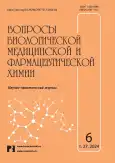Компонентный состав эфирного масла Artemisia santolinifoliA Turcz. ex Bess.
- Авторы: Преловская С.З.1, Рандалова Т.Э.1, Чимитцыренова Л.И.1, Намзалов Б.Б.1, Раднаева Л.Д.1
-
Учреждения:
- Бурятский государственный университет имени Доржи Банзарова
- Выпуск: Том 27, № 6 (2024)
- Страницы: 20-25
- Раздел: Фармацевтическая химия
- URL: https://journals.eco-vector.com/1560-9596/article/view/633503
- DOI: https://doi.org/10.29296/25877313-2024-06-03
- ID: 633503
Цитировать
Полный текст
Аннотация
Цель работы – сравнительный анализ качественного состава и количественного содержания компонентов эфирных масел, выделенных из разных органов полыни сантолинолистной (Artemisia santolinifolia Turcz. ex Bess.), и оценка влияния погодных условий на накопление и состав эфирных масел.
Материал и методы. Объект исследования – надземная часть A. santolinifolia, собранная в Окинском районе Республики Бурятия в фазу цветения, в августе 2016, 2017, 2019 гг. Эфирные масла выделяли методом гидродистилляции. Компонентный состав определяли методом газовой хромато-масс-спектрометрии на газовом хроматографе Agilent Packard HP 6890 c квадрупольным масс-спектрометром (HP MSD 5973N).
Результаты. Наибольшее содержание эфирных масел выявлено в полыни сантолинолистной соцветиях (0,7%) и листьях (0,7%), меньшее – в надземной части (0,5%), стеблях (0,4%). Монотерпеноиды в основном накапливаются в соцветиях, сесквитерпеноиды в большей степени содержатся в листьях и стеблях. Доминирующие компоненты, характерные для всех частей растения: 1,8-цинеол (1,5–9,1%), терпинеол-4 (0,7–2,8%), борнил-2-метилбутоноат (1,5–1,8), камфора (0,4–39,5%), борнеол (0,7–6,4%), борнилацетат (3,1–5,0%), давана эфир (изомер 1) (1,9–5,3%), давана эфир (изомер 2) (1,1–3,2%), даванон (0,6–12,4%), кариофиоллен (0,5–2,0%), бициклогермакрен (0,7–6,2%), спатуленол (0,8–19,9%). Вычислен гидротермический коэффициент экстремальности (Kэкстр), показана положительная корреляция между Kэкстр и содержанием эфирного масла в сырье.
Выводы. Впервые изучен компонентный состав эфирных масел, выделенных из соцветий, листьев, стеблей полыни сантолинолистной; идентифицировано 60 соединений, относящихся к моно- и сесквитерпеновым соединениям. Определены доминирующие компоненты эфирных масел. Исследование динамики накопления показало, что эфирные масла содержатся во всех органах растения, поэтому производится сбор всей надземной части растения, оптимальный срок сбора сырья – фаза цветения. Содержание эфирных масел зависит в большей степени от количества выпавших осадков, чем от среднемесячной температуры.
Ключевые слова
Полный текст
Об авторах
С. З. Преловская
Бурятский государственный университет имени Доржи Банзарова
Автор, ответственный за переписку.
Email: sayanaprelovskaya@gmail.com
ORCID iD: 0000-0003-4038-6270
к.фарм.н., доцент, кафедра фармации, ст. науч. сотрудник, лаборатория химии природных систем
Россия, Республика Бурятия, 670000, г. Улан-Удэ, ул. Смолина, 24аТ. Э. Рандалова
Бурятский государственный университет имени Доржи Банзарова
Email: sayanaprelovskaya@gmail.com
ORCID iD: 0000-0002-8458-559X
к.фарм.н., доцент., кафедра фармации, зав. лабораторией химии природных систем
Россия, Республика Бурятия, 670000, г. Улан-Удэ, ул. Смолина, 24аЛ. И. Чимитцыренова
Бурятский государственный университет имени Доржи Банзарова
Email: sayanaprelovskaya@gmail.com
ORCID iD: 0000-0003-1929-3985
к.фарм.н., доцент, кафедра фармации, ст. науч. сотрудник, лаборатория химии природных систем
Россия, Республика Бурятия, 670000, г. Улан-Удэ, ул. Смолина, 24аБ. Б. Намзалов
Бурятский государственный университет имени Доржи Банзарова
Email: sayanaprelovskaya@gmail.com
ORCID iD: 0000-0003-4560-1400
д.б.н., профессор, кафедра ботаники
Россия, Республика Бурятия, 670000, г. Улан-Удэ, ул. Смолина, 24аЛ. Д. Раднаева
Бурятский государственный университет имени Доржи Банзарова
Email: sayanaprelovskaya@gmail.com
ORCID iD: 0000-0003-2886-1075
д.х.н., профессор, зав. кафедрой фармации
Россия, Республика Бурятия, 670000, г. Улан-Удэ, ул. Смолина, 24аСписок литературы
- Блинова К.Ф., Куваев Б.Б. Лекарственные растения тибетской медицины Забайкалья. Вопросы фармакогнозии. 1965; 3: 163–178.
- Определитель растений Бурятии. Под ред. О.А. Аненхонова. Улан-Удэ: Респ. Типография. 2001; 672 с.
- Jacupovic J., Tan R. X., Bohlmann F., Jia Z. J, Huneck S. Seco- and norsesquiterpene lactones with a new carbon skeleton from Artemisia santolinifolia. Phyrochemistry. 1991; 30: 1941−1946.
- Прибыткова Л.Н., Ткачев А.В., Зоркальцев С.С., и др. Изучение химического состава и антиоксидантной активности полифенолов Artemisia santolinifolia. Сибирский медицинский журнал. 2011; 26(1(2)): 65−67.
- Цыбикова С.З., Раднаева Л.Д., Жигжитжапова С.В., Дымшеева Л.Д. Анатомо-диагностические признаки и показатели качества полыни сантолинолистной травы. Журнал научных ста-тей Здоровье и образование в XXI веке. 2018; 20: 102–106.
- Преловская С.З., Рандалова Т.Э., Жигжитжапова С.В., Раднаева Л.Д. Жирнокислотный состав Artemisia santolinifolia Turcz. exBess. флоры Бурятии. Вестник Бурятского государственного университета. Медицина и фармация. 2019; 3: 35‒41.
- Shatar S., Dung N. X., Karashawa D. Essential oil composition of some Mongolian Artemisia species. Journal of essential oil bearing plants. 2003; 3: 203−206.
- Намзалов Б.Б., Жигжитжапова С.В., Раднаева Л.Д. и др. К проблеме таксономического статуса Artemisia santolinifolia Turcz. ex Bess: хемосистематические аргументы и особенности окинской ценопопуляции вида (Восточный Саян). Проблемы ботаники Южной Сибири и Монголии: материалы XVI Междунар. науч.-практ. конф. Барнаул. 2017: 279−283.
- Ткачев А.В. Исследование летучих веществ растений. Новосибирск: Офсет. 2008; 969 с.
- Жигжитжапова С.В., Раднаева Л.Д., Намзалов Б-Ц.Б. Компонентный состав эфирных масел Artemisia abrotanum L. и близкородственных видов – A. adamsii Bess. A. messerschmidtiana Bess. A. santolinifolia Turcz. ex Bess. Вестник Бурятского государственного университета. Медицина и фармация. 2019; 3: 42–48.
Дополнительные файлы






